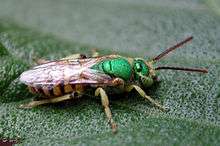Agapostemon
The genus Agapostemon is a common group of Western Hemisphere sweat bees, most of which are known as metallic green sweat bees for their color.
| Agapostemon | |
|---|---|
 | |
| Agapostemon texanus male | |
| Scientific classification | |
| Kingdom: | Animalia |
| Phylum: | Arthropoda |
| Class: | Insecta |
| Order: | Hymenoptera |
| Family: | Halictidae |
| Tribe: | Halictini |
| Genus: | Agapostemon Guérin-Méneville, 1844 |
They are members of the family of bees known as Halictidae. Like other sweat bees, they are attracted to human sweat, and they use the salt from the sweat for nutrition. They are generally green or blue, especially the head and thorax. Sometimes the abdomen in females is green or blue although it may be striped, and most males have the yellow-striped abdomen on a black or metallic background. They superficially resemble various members of another tribe, Augochlorini, which are also typically metallic green.
Nesting
All species of Agapostemon nest in the ground, sometimes in dense aggregations. Some species are communal such as A. virescens. In this and other communal species, multiple females share the same nest entrance, but beneath the common entrance burrow, construct their own portion of the nest. Thus each female digs her own brood cells and collects pollen and nectar to fashion the pollen ball upon which she will lay an egg.
Unlike other social bees, in communal bees there is no reproductive division of labor. The advantage of this form of sociality seems to be that cleptoparasitic Nomada bees have greater difficulty gaining access to the nest and brood cells when there are multiple females inside. This method of defense against the Cuckoo bee (Nomada) facilitates attacks by larvae of the Blister beetle.
Range
.jpg)
Some 42 species in the genus range from Canada to Argentina . In cool temperate regions, there is one generation per year, with females being active in the early summer and males and pre-diapausing females active in the late summer. Only mated females survive the winter. This is probably because unmated females cannot enter diapause.[1] Males can often be seen in large numbers flying around shrubs with large flowers, such as Rose of Sharon. Agapostemon angelicus are native to the Texas high plains. They specialized in being pollinators for cotton.[2] They can serve as replacement for honey bees in pollination[3]
Types of flight
Like other bees, A. texanus can fly from a short or long distance. Their flight patterns usually rely on flower density; they favor flowers with high densities. Their flight patterns best resemble the bumble bee and the honey bee.[4]
Species
Over 40 species of Agapostemon have been identified:[5]
- Agapostemon aenigma
- Agapostemon alayoi
- Agapostemon angelicus
- Agapostemon ascius
- Agapostemon atrocaeruleus
- Agapostemon boliviensis
- Agapostemon centratus
- Agapostemon chapadensis
- Agapostemon chiriquiensis
- Agapostemon coloradinus
- Agapostemon columbi
- Agapostemon cubensis
- Agapostemon cyaneus
- Agapostemon erebus
- Agapostemon femoratus
- Agapostemon heterurus
- Agapostemon inca
- Agapostemon insularis
- Agapostemon intermedius
- Agapostemon jamaicensis
- Agapostemon kohliellus
- Agapostemon krugii
- Agapostemon lanosus
- Agapostemon leunculus
- Agapostemon melliventris
- Agapostemon mexicanus
- Agapostemon mourei
- Agapostemon nasutus
- Agapostemon obliquus
- Agapostemon obscuratus
- Agapostemon ochromops
- Agapostemon peninsularis
- Agapostemon poeyi
- Agapostemon rhopalocerus
- Agapostemon sapphirinus
- Agapostemon semimelleus
- Agapostemon sericeus
- Agapostemon splendens
- Agapostemon swainsonae
- Agapostemon texanus
- Agapostemon tyleri
- Agapostemon viequesensis
- Agapostemon virescens
- Agapostemon viridulus
References
- Yanega, D. (1989-02-01). "Caste determination and differential diapause within the first brood of Halictus rubicundus in New York (Hymenoptera: Halictidae)". Behavioral Ecology and Sociobiology. 24 (2): 97–107. doi:10.1007/bf00299641. ISSN 0340-5443.
- Berger, L.A (23 March 1984). "Seasonal Cycles of Agapostemon angelicus Cockerell Relative to Hybrid Cottonseed Production in Texas (Hymenoptera: Halictidae)". Journal of the Kansas Entomological Society: 1–8.
- Berger, L.A. (23 March 1984). "Seasonal Cycles of Agapostemon angelicus Cockerell Relative to Hybrid Cottonseed Production in Texas (Hymenoptera: Halictidae)". Journal of the Kansas Entomological Society: 1–8.
- Waddington, Keith (28 December 1978). "Flight Patterns of Three Species of Sweat Bees (Halictidae) Foraging at Convolvulus arvenis". Journal of the Kansas Entomological Society: 751–758.
- Bisby F.A.; Roskov Y.R.; Orrell T.M.; Nicolson D.; Paglinawan L.E.; Bailly N.; Kirk P.M.; Bourgoin T.; Baillargeon G.; Ouvrard D. (2011). "Species 2000 & ITIS Catalogue of Life: 2011 Annual Checklist". Species 2000: Reading, UK. Retrieved September 24, 2012.
External links

- Agapostemon identification guide
- List of species
- Worldwide species map
- Genus Agapostemon on BugGuide